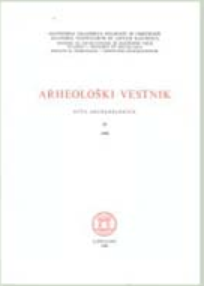Some Specimens of Early Prehistoric Plastic Art in Slovenia
Abstract
As to the present investigations prehistorical plastic a rt products are seerce in Slovenia th e chief reason thereof being the fact th a t th e territo ry was b u t little exam ined as to th e ea rlier periods. H itherto th ree statuettes have been excavated, one on the Moor of L jubljana, one at M aribor, and one at Ptuj. Chronologically the first one seems to be the earliest, w hile the other two are n early p arallel. Yet they differ as to their elaboration, respec[1]tively conception. Typological I y they represent th ree various types. The sta tu e tte from the Moor of L ju b ljan a corresponds to the anthropom orphic vases of the sam e site. Stylization has reaiched its acme th ere though this statu ette b e the earliest one. The one of M aribor is the most naturalistic. As fa r as the statuettes are ornam ented th e ir ornam ents represent clothing, respectively tex tile ornam ents. O n the statu ette of M aribor Schuchardt saw also a kind of a sk irt of grass or some sim ilar m aterial, w hich is very doubtful. It has been .estab lish ed th a t the statu ette of L ju b ljan a belongs to the Slavo[1]nian culture, and the one of P tu j to the Illy rian culture, chronologically somehow to the transition from the Bronze into the H allstadt Period. The statu ette of M aribor is likely to belong to the Illy rian culture] as well, though the d ata of its excavation be rath e r uncertain. O ur statu ettes originate from the D anube valley. The one of L ju b ljan a m ay be rem iniscent of the N eolithic Period, b u t the other two- have originated u n d er th e influence of th e Slavonian cu ltu re m any elem ents of w hich have been found in the Illy rian settlem ent on the C astle of P tu j sim ultaneously w ith the sta tu e tte itself. O th er plastic a rt products are represented by anthropom orphic vases from th e Moor of L ju b ljan a corresponding stylistically to the statu ette from th e re as well. The ornam ents rep resen t te x tile motives taken from the clothing in nature. It is not clear w hat th e purpose of th e anthropom orphic! vasea was. They m ight have been eith er cult vessels or even -idols, though it seems •rather unlikely. T here are some m ore vessels th a t m ight b e included into plastic vases, and th a t w ere probably not used in everyday life, b u t to some special purpose. Such is a v ery rough vase in the shape of a shod foot or a shoe, fu rth e r a fragm ent of a vessel w ith a very thin neck w hich is covered by a sm all p late w ith tw o little holes. Sim ilar ones are to be found in the area of th e D anubian N eolithic cu ltu re at Vinca (Vasic calls them arybaloses and candelabrum -shaped vases), and at B utm ir as well. Also a p itcher m ay be included; it is interesting on account of its having been flatly com pressed w hile being m anufactured, and sem icircularly w ound. Its purpose is not clear. O n the Moor of L ju b ljan a also clay rattles are fre q u e n t They are m ade in biconical shapes, in the shape of a common hum an statuette, and in the shape of some flying anim al. The la tte r two w ere variously in terp reted . The first one as a cow ering owl, the second one as a hedgehog. All of them w ere on a cord, and represented am ulets against bad ghosts. They are not likely to have been children’s toys, and little likely to have been cult or ritu a l objects. A -plastic object from the C astle of P tu j m ay represent phallus owing to its shape. It belongs to the Illy rian culture. W ith p lastic products in Slovenia w e cannot speak about th eir artistic degree, b u t a t the m ost about the degree of trad e art. The chief aim was not th e shape, b u t the contents. T here are b u t few individual peculiarities of the producer to be noticed. Most products are m ade by routine
Downloads
Downloads
Published
How to Cite
Issue
Section
License

This work is licensed under a Creative Commons Attribution-NonCommercial-ShareAlike 4.0 International License.
Authors guarantee that the work is their own original creation and does not infringe any statutory or common-law copyright or any proprietary right of any third party. In case of claims by third parties, authors commit their self to defend the interests of the publisher, and shall cover any potential costs.
More in: Submission chapter





